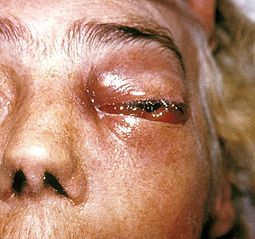Mucormycosis
| Mucormycosis | |
|---|---|
 |
|
| Classification and external resources | |
| Specialty | infectious disease |
| ICD-10 | B46.0-B46.5 |
| ICD-9-CM | 117.7 |
| DiseasesDB | 31759 |
| MedlinePlus | 000649 |
| Patient UK | Mucormycosis |
| MeSH | D009091 |
Mucormycosis is any fungal infection caused by fungi in the order Mucorales. Generally, species in the Mucor, Rhizopus, Absidia, and Cunninghamella genera are most often implicated.
The disease is often characterized by hyphae growing in and around blood vessels and can be potentially life-threatening in diabetic or severely immunocompromised individuals.
"Mucormycosis" and "zygomycosis" are sometimes used interchangeably. However, zygomycota has been identified as polyphyletic, and is not included in modern fungal classification systems. Also, while zygomycosis includes Entomophthorales, mucormycosis excludes this group.
Mucormycosis frequently infects the sinuses, brain, or lungs. While infection of the oral cavity or brain are the most common forms of mucormycosis, the fungus can also infect other areas of the body such as the gastrointestinal tract, skin, and other organ systems. In rare cases, the maxilla may be affected by mucormycosis. The rich blood vessel supply of maxillofacial areas usually prevents fungal infections, although more virulent fungi, such as those responsible for mucormycosis, can often overcome this difficulty.
There are several key signs which point towards mucormycosis. One such sign is fungal invasion into the blood vessels which results in the formation of blood clots and surrounding tissue death due to a loss of blood supply. If the disease involves the brain, then symptoms may include a one-sided headache behind the eyes, facial pain, fevers, nasal congestion that progresses to black discharge, and acute sinusitis along with eye swelling. Affected skin may appear relatively normal during the earliest stages of infection. This skin quickly becomes reddened and may be swollen before eventually turning black due to tissue death. Other forms of mucormycosis may involve the lungs, skin, or be widespread throughout the body; symptoms may also include difficulty breathing, and persistent cough. In cases of tissue death, symptoms include nausea and vomiting, coughing up blood, and abdominal pain.
...
Wikipedia
